Crystalline structure of hydroxyapatite present in the femur of wistar rat with induced diabetes
Abstract
Bone is a tissue that is classified as a composite material. In living beings, bones, in addition to having a structural function, are also a storage site for minerals. The basic structure of bone is procollagen units and hydroxyapatite crystals, the latter with both atomic (Na+1, K+1, Mg+2, Ca+2, F-1, Cl-1) and molecular (CO3-2) ion substitutions. The ionic substituents vary according to the environment of the bone and some diseases such as diabetes can affect the substitution. In this work, the x-ray diffraction patterns of femurs extracted from wistar rats with induced diabetes are reported. In these diffractograms, differences were observed in the main signal (211), so the rietveld refinement was used to identify the crystalline phases for their quantitative estimation. The results show the effect of induced diabetes on the quality of hydroxyapatite.
Downloads
References
Ardanova, L. I. (2010). Isomorphous Substitution of Rare Earth Elements for Calcium in Synthetic Hydroxyapatites. Inorganic Chemistry, 10687-100693.
Fleet, M. E. (2017). Infrared spectra of carbonate apatites: Evidence for a connection between bone mineral and body fluids. American Mineralogist, 149-157.
Fleet, M. E. (2004). Accommodation of the carbonate ion in apatite: An FTIR and X-Ray structure study of crystals synthesized at 2-4 GPa. American Mineralogist, 1433-2432.
Gshalaev, V. S. (2012). Hydroxyapatite; Synthesis, Properties and Applications. New York: NOVA BIOMEDICAL.
Kniess, C. T. (2012). The quantificacion of crystalline phases in materials: applications of rietveld method. intech.
Legros, R. A. (1987). Age-Related Changes in Mineral of Rat and Bovine Cortical Bone. Calcifiet Tissue International, 137-144.
Li, Z. A. (2014). Chemistry of bone mineral based on the hypermineralized rostrum of the beaked whale Mesoplodon densirostris. American Mineralogist, 645-653.
Lutterotti L, (2003). Object oriented programming and fast computation techniques in MAUD, a program for powder diffraction analysis written in java. IUCr: Compcomm Newsletter, 1:43–50.
Pasteris, J. D. J. (2008). Bone and Tooth Mineralization: Why Apatite?
Setiawati, R. A. (2018). Bone Development and Growth. IntechOpen , 01-020.
Tortora, G. J. (2004). Principios de Anatomía y Fisiología. México: Editorial Medica Panamericana.
Vandecandelaere, N. A. (2012). Biomimetic apatite-based biomaterials: on the critical impact of synthesis and post-synthesis parameters. Springer, 2593-2606.
Yoder, C. H. (2016). The relative stabilities of A- and B-type carbonate substitution in apatites synthesized in aqueous solution. Mineralogical Magaine, 977-983.













